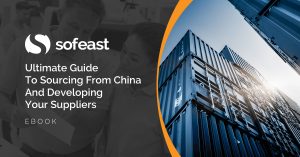Back in February (which seems to be a long time ago), I wrote that that number 1 manufacturing risk for importers was quality issues and the number 2 was delivery delays.
(I also mentioned “lower demand on your market” because we were “getting to the end of a long cycle of economic expansion”. That proved to be number 1 risk, actually!)
But, let’s get back to the suppliers’ quality & delivery performance and why short term focus has continued to impact them and their reliability…
The effect of Chinese New year
Chinese New Year has always been a source of strong instability:
- Before CNY, there is intense pressure to ship productions out on time, and the ‘quality gate’ is often ignored;
- After CNY, many operators, inspectors, and engineers are still in training.
Then, in February 2020, the shortage of workers was more severe than ever. Key employees were blocked and could not go back to work for weeks or months. Every manufacturing company was out of its comfort zone and trying to get by as they could.
Why things did NOT get back to normal in April this year
Things could have gotten back to normal in April. But they did not, for several reasons:
- More and more importing countries got hit by the pandemic, stores closed, and orders were either postponed or cancelled.
- Many companies jumped on the PPE-making bandwagon (face masks, isolation gowns, IR thermometers…) and got distracted away from their core productions.
- Many buyers’ teams (quality, engineering…) traditionally fly to China and Vietnam and visit their suppliers’ factories. Not this spring, though. There is no pressure to follow the right systems and processes.
If I sum all this up, it is a focus on the short term. And it is directly impacting the reliability of Chinese manufacturers. They have more inconsistent quality, a lower ability to forecast their production-ready dates, etc.
What’s the effect of short term focus?
Why is this focus on the short term inhibiting all efforts at keeping systems in place and on improvement in general?
Lex Sisney wrote about this, in the context of org charts:
Just as efficiency overpowers effectiveness, the demands of today always overpower the needs of tomorrow.
That’s why the pressure you feel to do the daily work keeps you from spending as much time with your family as you want to. It’s why the pressure to hit this quarter’s numbers makes it so hard to maintain your exercise regime. And it’s why you never want to have functions that are focused on long-range development (branding, strategy, R&D, people development, etc.) reporting to functions focused on driving daily results (sales, running current marketing campaigns, administration, operations, etc.).
For example, what happens if the marketing strategy function (a long-range orientation focused on branding, positioning, strategy, etc.) reports into the sales function (a short-range orientation focused on executing results now)? It’s easy to see that the marketing strategy function will quickly succumb to the pressure of sales and become a sales support function. Sales may get what it thinks it needs in the short run but the company will totally lose its ability to develop its products, brands, and strategy over the long range as a result.
I am a fan of Sisney’s analyses in general (and you can grab his book here). It is really true in the China manufacturing world.
I wrote before about the habit of many manufacturing and supply chain managers to be constantly in “firefighting mode”, for example.
Are the problems only on the manufacturer’s side?
Oh, and is this only on the manufacturer’s side? Of course not. Many buyers are febrile these days. We get a lot more “ASAP” requests than usual.
A case in point is the rush on buying PPE from China. Many buyers send emails when it is 2 am their time! Deals worth millions of dollars get closed in 10 minutes. There is barely time to do any due diligence, factory audits, or product inspections.
When most potential clients used to email us for the initial inquiry, we are instead getting many calls every day. They want an answer now.
To avoid having to spend too much time answering phone calls and emails, we have compiled a resource page on coronavirus medical supplies. It includes an overview of some of the standards required to import into the USA and into the EU, as well as the services we provide to PPE buyers.
*****
All this frenzy is getting everybody tired. Some people thrive on it, but it is definitely not a healthy state.
What about your company, and your suppliers? Are you seeing this short term focus as well?
Ultimate Guide To Sourcing From China And Developing Your Suppliers [eBook]
This FREE eBook starts from the beginning, discussing whether you need to hire a sourcing agent, and follows the sourcing process right through to developing a trusted supplier’s quality and productivity.
There are 15 chapters over 80+ pages to explore, providing exhaustive guidance on the entire sourcing and supplier development process from start to finish, including:
- Identifying suppliers,
- Negotiations,
- Quality inspections,
- Developing Chinese suppliers,
- Improving factory quality and productivity,
- and much more…


